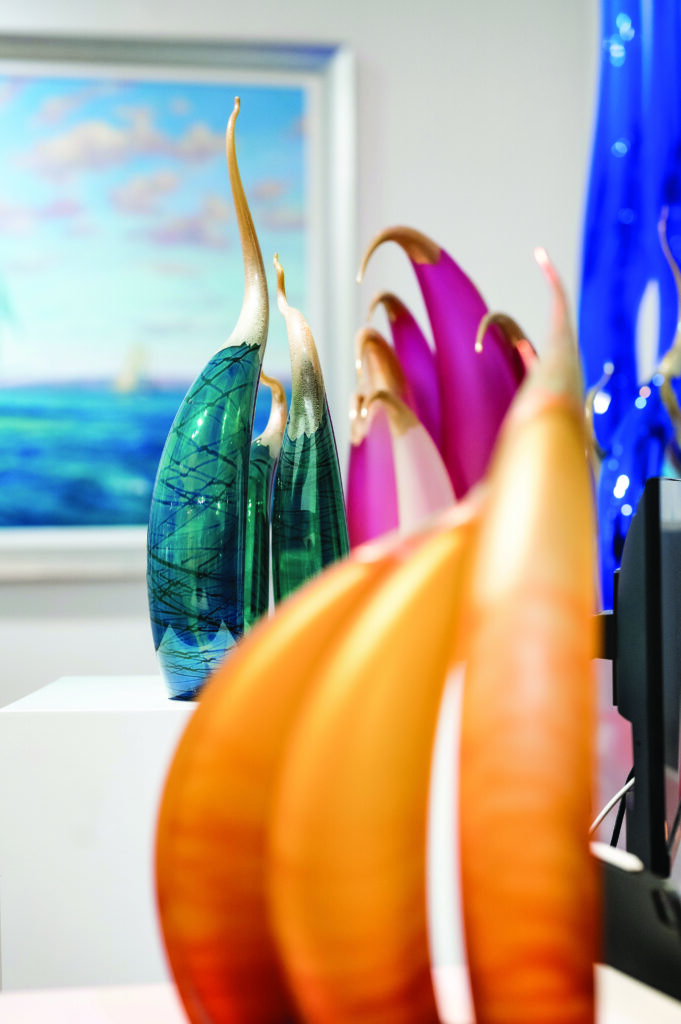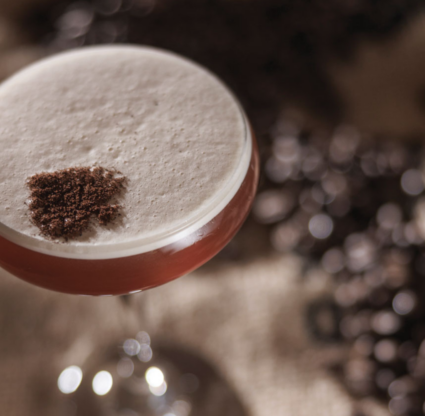Stepping off Naples’ Fifth Avenue South and into Shaw Gallery is like stepping into another dimension. Light moves differently in this corner of the world, refracting through translucent obelisks and glinting off anthropomorphic sculptures in repose. At any moment, when owner Jay Shaw decides to push a button on a small remote, the lighting changes, transforming the space again.
The gallery is at once a repository of fine art, a playground and a classroom for Jay, an art novice-turned-gallerist. A list of university credentials does not follow his title; Jay’s keen eye evolved organically through family and conversations with living artists worldwide. His excitement and curiosity engender a spirit of investigation and necessitate him to create a space worthy of the work that speaks to him.
Jay’s grandparents built Shaw Gallery on Fifth Avenue in 1988 to display the work of his sculptor grandfather, Kenneth Shaw. Over the years, the space developed to include sculptures and paintings from renowned international artists. Meanwhile, Jay was living in California, periodically visiting his grandparents and marveling at the easy-going way of life people seemed to enjoy in Naples.
Ten years ago, at 21, the then-car salesman moved to Naples and started working with his grandmother, launching his experience-driven study of art. Jay remembers the first piece he purchased for his personal collection in his early years at Shaw. The painting depicted the bridge where he proposed to his wife, Marla, who co-owns the gallery with him. “I fell in love with the painting—the emotion it gave me,” Jay says. He saw the art through the eyes of a collector who buys for passion and connection, not simply investment potential.
A visit to the Imagine Museum, a trove of contemporary glass art a couple hours north in St. Petersburg, in 2020 opened his eyes to the wide-ranging marvels of modern-day glass art. “They had the most incredible collection of glass sculptures I had ever seen, at scales I didn’t even know were possible,” Jay says. When he saw the work of Dutch-born artist Peter Bremers—with its imposing abstract forms that catch and refract light with intention—the curator-in-training knew what he wanted to focus on. “I thought, ‘I want my gallery to look like this,’” he says.
That year, Jay purchased Shaw Gallery from his grandmother and dove head first into the world of glass, pulling on his family’s existing connections with glass artists Toland Sand and Richard Royal to entice other contemporary makers to work with him. Jay made cold calls to Chicago, the Netherlands, the Czech Republic and beyond, leaving earnest voicemails when his calls went unanswered. The strategy was a long shot, but it paid off.
Today, Shaw Gallery represents 19 well-regarded glass artists. And, while Jay still sells in other mediums—Andre Kohn’s paintings are prominently featured—the gallery primarily focuses on glass.
In the brightly lit labyrinthine gallery, Peter Bremers’ complex sculptures, recalling glaciers, canyons and waves, stand among works by Rick Eggert, Hiroshi Yamano and Chicago native Jon Kuhn, known for his galactic-esque cubes. “It’s a labor of love for these guys. I’ll be talking to Jon Kuhn on the phone, and he’ll say, ‘Man, the second you sell that, I’m going to take all that money and make an even bigger piece.’ He’s got all these big dreams and visions, and he just wants to make art. I love that,” Jay says.
Awe is at the core of Jay’s practice. When he first laid eyes on Bremers’ large-scale installations, he wondered how glass could convert into such massive scales; how could a 1,000-pound sculpture be transported from the Czech Republic to Florida without a scratch? He’s eager to represent artists whose work and processes can inspire a sense of wonder in others—whether through innovation or near-obsessive commitment to the craft. He thinks of creators like Toots Zynsky, who turns glass into silky-thin threads, which are fused to form undulating vessels that seem wrapped in fabric, and the technique Bremers developed with a chemist to create a more flexible glass that can expand and contract in harsh temperatures without shattering. “That’s something no one else is doing,” Jay says of Bremers’ outdoor glass sculptures.
The gallerist gestures to a Kuhn prismatic cube sculpture, Blue Jewel (2023), on a nearby pedestal. Jay notes how the artist applies countless cuts to his glass sculptures, etching the surface to form innumerable light refractions. “He’s got sculptures that took a million cuts to create,” Jay says. The primarily transparent piece emanates bright yellow and rich blue hues from within and casts a rainbow of refracted light onto its custom marble pedestal.

Jay is fascinated by light and how it interacts with glass. Perhaps more than with any other medium, light informs the art, revealing intricacies in the design, color and internal structure. Depending on how a glass sculpture is lit, it can appear more iridescent, vibrant or textured; it can cast shadows and refractions; it can look perfectly still or appear to come alive with swirling movement. Jay recently installed smart lighting leader Ketra, a color-tunable lighting system used in The Art Institute of Chicago and Missouri’s Nelson-Atkins Museum of Art. The LED system can adjust color, temperature and brightness in millions of combinations and with microprecision to show how different conditions can radically transform a piece. In Bremers’ Icebergs & Paraphernalia (2017), cool blue and white tones whirl brilliantly beneath the surface of the sculpture’s sharp edges when cast in blue light. “If you put warm light on the piece, it gets dark and washes away, but if I put the widest, brightest, purest, 10,000 Kelvin light on it, it comes to life. I could make it look just like the iceberg,” Jay says.
In addition to his salesmanship, Jay’s zeal for taking chances and adopting new technologies is key to Shaw Gallery’s success. Two weeks before Hurricane Ian hit in 2022, the rent for Shaw Gallery doubled, and Jay was slapped with a tax bill that would have cleaned out his savings. Then, the flooding came. Jay, Marla and their friend, Alberto, who works in the gallery, safely removed all of the art in time, but the financial burden of repairs, rent and taxes was insurmountable. Rather than walk away, Jay took out a big loan and improved the space, equipping it with an AI-driven audio tour system and the Ketra lighting.
As the gallery continues its post-Ian upswing, Jay sets his sights on the future. “The goal is to keep growing,” he says. He looks to build a larger gallery in Naples to represent the nearly 150 glass artists on his radar. “It’s so fun to watch artists come up with different ideas and different designs,” Jay says. “They’re always trying to push the limit—to come up with something new that no one’s done before. Who knows what they might do next.”





